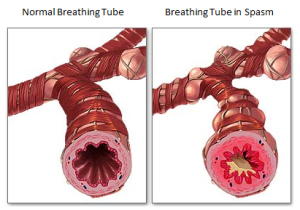Mechanism of Breathing
What is normal mechanism of breathing?
- NASAL BREATHING. It protects the airways by humidifying, warming, and cleaning the air entering the lungs
- A gentle wave pattern of 8-10 breaths per minute which will move the correct volume of 4-5 litres of air per minute in and out of the lungs
- Diaphragmatic breathing – breathing from the diaphragm, not through the chest – with no upper chest or shoulder movement
- Breathing slowly and silently

Why do we breathe?
- To deliver oxygen to all body cells
- To remove excess carbon dioxide (CO2)
Oxygen
- Body requirement is 2-3%
- Atmospheric content is 21%
- Oxygen does not have to be stored in the body. It is always available
Carbon Dioxide
- Body requirement is 6.5% or 40mm of Hg
- Atmospheric content is 0.03%
- It has to be produced and stored by the body
- It is produced as a by-product of exercise and digestion
- It is stored in the lungs at 6.5%
- It is stored in arterial blood at 40mm of Hg

What does oxygen do?
- Oxygen has only one task in the body – to regenerate the cells.
What does CO2 do?
- Triggers our breathing mechanism
- Prevents smooth muscles from going into spasm
- Facilitates the release of oxygen from hemoglobin (the protein in the blood)
- Maintains the correct pH (acid-base) balance in the blood

What happens if CO2 levels become too low?
- Breathing pattern becomes abnormal and erratic.
- Smooth muscles may go into spasm.
Smooth muscles can be found in blood vessels, respiratory and gastrointestinal tracts, reproductive organs, urinary tract, and many other parts of the body. That is why smooth muscles spasm can lead to all kinds of disorders including high blood pressure, asthma, COPD, anxiety and panic attacks, and many other conditions. Body cells do not get enough oxygen as it is not adequately released from the haemoglobin in the blood. If not enough oxygen is getting released to the cells, cells will not function properly. This will cause a wide range of disorders and medical conditions. If pH of the blood becomes too alkaline, the brain will instruct breathing to stop so that CO2 can increase to safe levels. This is one of the major causes of sleep apnea.
Constantly low levels of CO2 which result from mouth breathing, cause the breathing trigger to reset itself to the lower level. This will cause overbreathing to continue on a permanent basis, but it will be perceived by the body as a normal breathing.
What causes CO2 levels become too low?
Breathing more air than body needs which is called OVERBREATHING. There is another word for this: HYPERVENTILATION. Chronic overbreathing means that we habitually breathe more air than our body requires. Like overeating can have harmful effects on our body, so does breathing too much. It can harm us long term.
![]()

